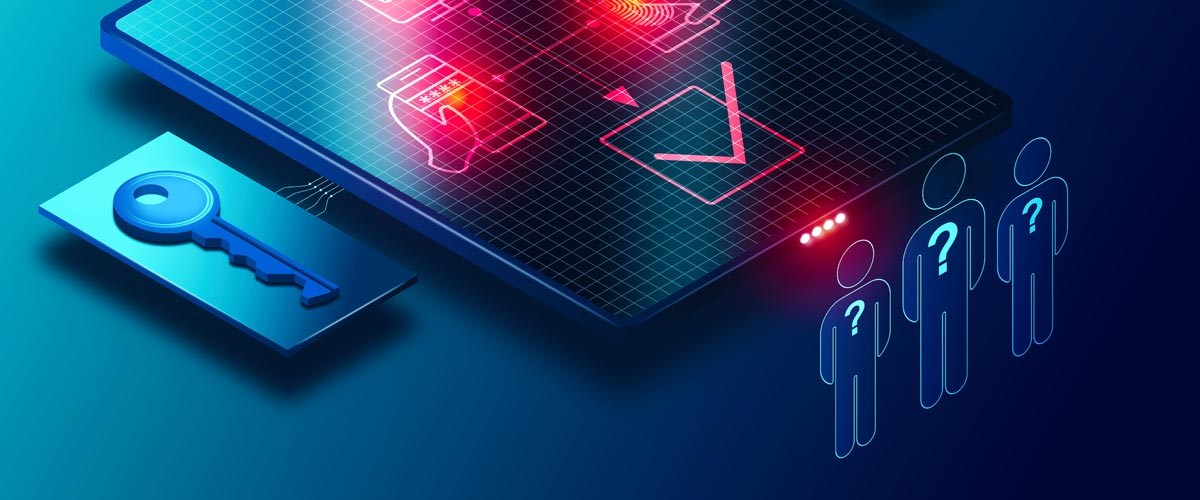
Online security has become a top priority for individuals and organizations alike. Traditional password-based logins have been the norm for years, but they come with their own set of challenges and vulnerabilities. Passwords can be easily stolen, are often weak and reused, and are many times forgotten or lost. Fortunately, passwordless is gaining popularity and providing a more secure and convenient way to log in.
Understanding Passwordless Logins
Passwordless authentication is an improved approach to online security that eliminates the need for traditional passwords. Instead of relying on memorized passwords, passwordless authentication uses a variety of unique authentication methods that are specific to the user. These authentication methods can include biometric factors, such as facial recognition or fingerprint scans, that identify the user based on their unique physical characteristics. Additionally, passwordless authentication may use security keys, which are small USB devices that generate unique codes for each login attempt. Other authentication methods include one-time passcodes delivered via email or SMS, as well as Google and Apple Passkeys, which are unique keys stored on a user's mobile device. By using these alternative methods, passwordless authentication provides a more secure and convenient way to log in to online accounts.

The Benefits of Passwordless Logins
The benefits of passwordless logins are numerous and significant. From enhanced security to improved user experience to simplified account management, passwordless authentication there are many reasons why it has become the preferred method for online security:
- Enhanced Security: Passwordless authentication eliminates the vulnerabilities that come with traditional passwords. It provides an additional layer of protection against credential theft and phishing attacks, which are significant sources of cybercrime.
- Improved User Experience: Passwordless authentication offers a more convenient and streamlined user experience. It eliminates the need to remember multiple passwords and reduces password fatigue, making it easier to manage and access online accounts.
- Simplified Account Management: Passwordless authentication simplifies account management by eliminating the need for password resets and account recovery hassles. It also provides centralized authentication systems that make it easier to manage and secure online accounts.
Implementing Passwordless Logins
Implementing passwordless logins requires careful consideration of various factors to ensure a smooth and secure transition. One of the first steps is to assess compatibility and requirements, which involves evaluating whether the chosen passwordless authentication method is compatible with the devices and platforms being used. Additionally, it is important to ensure that online services and applications support the chosen method.
Choosing the right passwordless authentication method is critical and should be based on various factors. It is essential to consider user preferences, accessibility, and any trade-offs between security and usability. For example, biometric authentication methods may be more convenient for users, but they may have certain limitations in terms of accessibility. Similarly, security key authentication methods may be more secure but may require additional hardware.
Once the appropriate passwordless authentication method has been selected, it is important to provide a step-by-step guide to setting it up for users. This guide should explain how to register for passwordless authentication with online services, how to configure authentication methods, and how to troubleshoot any issues that may arise. By following these guidelines, organizations can implement passwordless logins securely and efficiently.

Best Practices for Passwordless Logins
Best practices for passwordless logins involve implementing additional layers of security to ensure optimal protection against unauthorized access. One of the most effective ways to do this is to enable multi-factor authentication (MFA), which requires users to provide two or more forms of authentication before accessing an account. This can include a combination of something the user knows (e.g., a password), something the user has (e.g., a security key), and something the user is (e.g., biometric factors).
In addition to MFA, using passkeys, such as Apple Passkeys or Google Passkeys, in conjunction with passwordless authentication can provide an additional layer of security. Passkeys are unique cryptographic keys that are stored on a user's device and are used to prove the user's identity during the authentication process. They can be used as a substitute for passwords or in conjunction with passwordless authentication methods, such as biometric authentication or security keys.
By combining MFA and passkeys with passwordless authentication, organizations can provide an additional layer of protection against unauthorized access, ensuring that only authorized users have access to online accounts and sensitive data. Additionally, organizations should regularly review and update their security policies and procedures to ensure that they remain up to date. This can include educating users on best practices for passwordless authentication and conducting regular security audits and assessments.
Addressing Concerns and Misconceptions of Passwordless Logins
Implementing passwordless authentication can raise concerns and misconceptions among users, such as privacy and data protection considerations. Organizations must address these concerns and ensure that they comply with applicable laws and regulations to protect users' personal data.
Resistance to change and user adoption challenges are also common concerns when implementing passwordless authentication. Some users may be hesitant to adopt new authentication methods, making it important to educate them on the benefits of passwordless authentication, how it works, and how it will improve their online security.
Another concern is the fear of lockout or loss of access. Users may worry that if they lose their authentication device or if there are technical issues, they will be locked out of their account. Organizations must address these concerns by providing clear instructions for users on how to recover access to their account in the event of an issue.
By addressing these concerns and misconceptions, organizations can increase user adoption of this more secure and convenient approach to online security.
Real-World Examples and Success Stories of Passwordless Logins
Many organizations have already implemented passwordless authentication and have reported significant benefits:
- Microsoft: In 2019, Microsoft announced that it had eliminated passwords for its employees by implementing a passwordless authentication system. According to a blog post by Microsoft, the company saw a 99.9% reduction in account compromise attacks after implementing passwordless authentication. The company used a combination of Windows Hello biometric authentication and FIDO2 security keys to achieve this.
- Dropbox: Dropbox, a popular file-hosting service, implemented passwordless authentication in 2018. According to the company, passwordless authentication has reduced the number of account takeover attacks by 60%. Dropbox uses a combination of security keys and mobile authenticator apps to provide passwordless authentication.
- Google: Google has been promoting passwordless authentication for some time. In 2020, the company announced that it had enabled passwordless authentication for 150 million users across Android and iOS devices. Google uses its own proprietary authentication app called Google Authenticator, which generates one-time passcodes and enables users to sign in without passwords.
- Okta: Okta, an identity management company, offers passwordless authentication to its customers. According to the company, passwordless authentication can reduce helpdesk calls related to password resets by up to 70%. Okta uses a variety of authentication methods, including FIDO2 security keys and biometric factors, to provide passwordless authentication.
These examples demonstrate that passwordless authentication can be an effective way to enhance online security and simplify the login process for users.

Frequently Asked Questions (FAQs) for Passwordless Logins
Common questions about passwordless logins include whether they are truly more secure, what happens if you lose your authentication device, and whether passwords can still be used as a backup option. The answers to these questions depend on the specific implementation and requirements of the organization.
Q: Are passwordless logins more secure than traditional password-based logins?
Passwordless logins are generally considered to be more secure than traditional password-based logins as they eliminate the need for users to remember passwords, which are often weak and can be easily stolen or hacked. Passwordless authentication methods, such as biometric factors and security keys, are unique to the user and offer a higher level of security. However, the overall security of passwordless logins depends on the specific implementation and requirements of the organization.
Q: What happens if you lose your authentication device?
If a user loses their authentication device, they may be locked out of their account. To avoid this, organizations should provide users with a backup authentication method, such as a backup security key or a temporary password. Additionally, organizations should have clear procedures in place to help users recover their accounts in case of a lost authentication device.
Q: Can passwords still be used as a backup option?
While passwordless authentication methods eliminate the need for traditional passwords, some organizations may choose to offer passwords as a backup option. This can provide an additional layer of security in case the primary authentication method fails. However, passwords as a backup option can also increase the risk of password-related attacks, such as phishing and credential stuffing.
Q: Is passwordless authentication accessible to all users?
Some passwordless authentication methods, such as biometric factors, may not be accessible to all users, such as those with disabilities or injuries that affect their physical characteristics. Additionally, passwordless authentication methods may require specific hardware or software, which may not be available to all users. To ensure accessibility, organizations should offer alternative authentication methods for users who cannot use passwordless authentication.
Overall, the answers to these questions will depend on the specific implementation and requirements of the organization. It is important to carefully evaluate the benefits and drawbacks of passwordless logins and assess the needs and preferences of users before implementing them.
Conclusion
Passwordless authentication is an improved approach to online security that eliminates the need for traditional passwords. Passwordless authentication methods such as biometric factors, security keys, and one-time passcodes offer a more secure and convenient way to log in to online accounts. However, careful consideration and planning are required to ensure a smooth and secure transition to passwordless authentication. This includes assessing compatibility and requirements, choosing the right authentication method, and implementing additional security measures such as multi-factor authentication and passkeys. Addressing concerns and misconceptions, such as privacy and data protection considerations, resistance to change, and user adoption challenges, is also essential to ensure user buy-in and a successful implementation. Overall, organizations that implement passwordless authentication can improve online security, reduce the risk of password-related attacks, and simplify the login process for users.
Kensington is a leading provider of biometric security products that offer a higher level of assurance for security-conscious consumers and enterprise customers. VeriMark™ Guard is a compact and portable USB security key that offers advanced biometric authentication features, including fingerprint recognition and anti-spoofing technology. It is compatible with Windows Hello and FIDO2, ensuring compatibility with a wide range of applications and devices. It can help organizations enhance their online security and protect sensitive data from unauthorized access. If you are looking to secure your IT infrastructure and protect your data, Kensington's team is here to help. Our experts can help you assess your security needs and recommend the best products and solutions for your organization.
Learn more about Kensington’s® Biometric Security Solutions.
